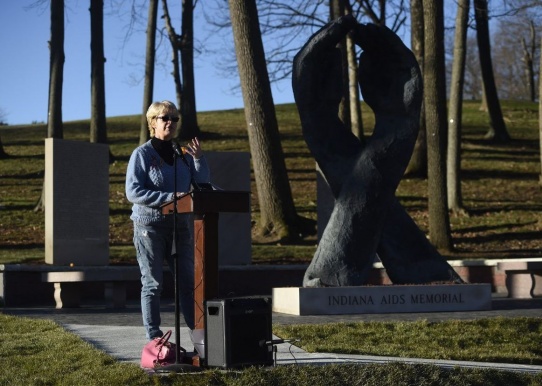
|
Indianapolis, IN United States |
Crown Hill Cemetery, 700 West 38th Street, Northeast corner of section 90 | Indiana AIDS Memorial |
since 29 October 2000 138 names |
David Irish remains a robust part of his family’s life, even after his death 25 years ago. They celebrate the Greenwood native’s birthday every year. Special family meals include Yorkshire puddings, his favorite. Someone always has to shove a bite full of gravy into their mouth and yell out, “For David!” Every year near the date of Irish’s death, his mother and two sisters go on a trip. They toast him with a Madras, his favorite cocktail, and wear corsages of yellow roses, which he bought his mother Margaret Irish every year for her birthday. “That’s the tribute we make, just so he’s not forgotten, so that my kids can hear the stories about him, and it’s ongoing,” said Julie Hustava, David Irish’s sister.
Traditions help keep David Irish’s memory alive. At the same time, a serene monument inside Crown Hill Cemetery helps honor him and other Indiana natives who have died from AIDS. The Indiana AIDS Memorial was created to remember the impact the epidemic has had in the community. As people gathered Friday for the re-dedication of the monument, there was celebration of the progress that’s been made in the recognition of AIDS victims, but also resolve that much remains to be done. “Hopefully, this brings more awareness to the memorial,” Hustava said. “(David) would be very pleased with this. He always talked about ‘The Cause,’ that we need to make people aware of it. That’s what this does. With all of the melting pot of names on there, it’s not just homosexuals. It runs the gamut.”
Under crisp blue skies Friday morning, about 50 people gathered around the monument in recognition of World AIDS Day. Survivors, family and friends, and other involved in the fight against the disease paid respects to the Indiana residents that have died from AIDS. People walked up the renovated walkway around the bronze monument, quietly reflecting in front of the massive entwined hands. Others looked for names inscribed on limestone tablets around the sculpture. At the base of one of those tablets, Hustava had laid a single yellow rose, for David.
For about an hour, speakers involved with the creation of the memorial, as well as its upkeep, spoke to the crowd about its importance. Dennis Stover, director of the HIV/STD viral hepatitis division of the Indiana State Department of Health, talked about the challenges that AIDS and other diseases pose to the community. Keith Norwalk, president of Crown Hill Funeral Home and Cemetery, discussed what the memorial has provided to the community. Though advancements and treatments for the disease have allowed AIDS patients to live longer, much work remains in eliminating AIDS, said Jason Grisell, president and CEO of the Health Foundation of Greater Indianapolis. “The memorial that stands behind me is a testament to the fight that occurred early on in this epidemic, and to the fight that continues today,” he said. “We can be dazzled by the advancements in science and medicine, but it’s access to these medications, access to health care and insurance, substance abuse and mental health treatment, issues of stigma, racism, bigotry and prejudice that continue to be barriers to ending this disease.”
The Indiana AIDS Memorial was created in 2000 at Crown Hill Cemetery. At the time, it was one of only four monuments in the U.S. dedicated to victims of the epidemic, joining ones in San Francisco, Los Angeles and Key West, Florida. It was the only one in a cemetery. The centerpiece sculpture by artist Guy Grey features a pair of intertwining hands which form the shape of a lapel ribbon. Around the monument, a semi-circle of limestone tablets features 138 names of Indiana residents or natives who have died from AIDS.
This year, organizers have added $75,000 in improvements to the site, including new landscaping, benches and walls, as well as a better pathway to reach the memorial.
Photo (c) Ryan Trares Daily Journal
1 December 2017
Ryan Trares, Indianapolis



















